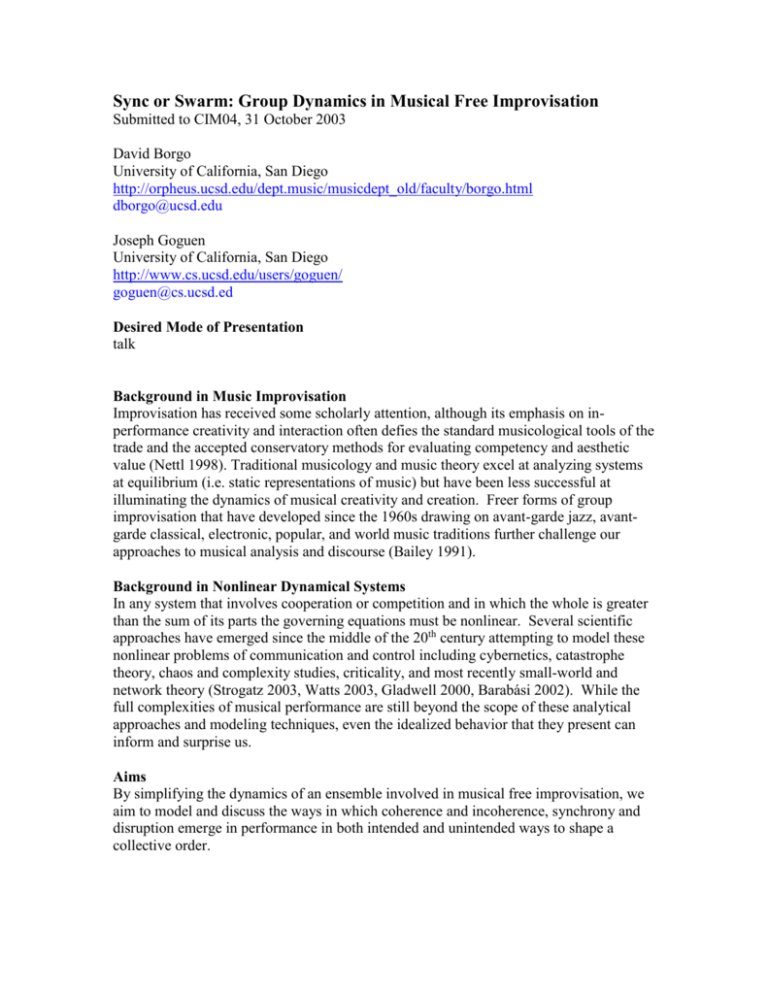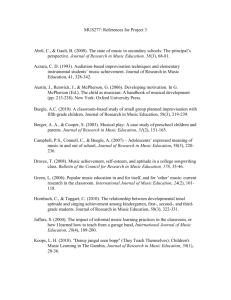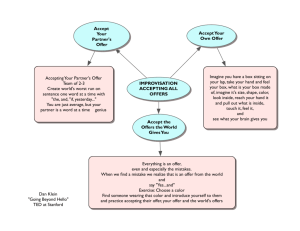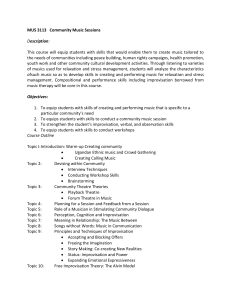Sync or Swarm: The Ensemble Dynamics of Musical Free
advertisement

Sync or Swarm: Group Dynamics in Musical Free Improvisation Submitted to CIM04, 31 October 2003 David Borgo University of California, San Diego http://orpheus.ucsd.edu/dept.music/musicdept_old/faculty/borgo.html dborgo@ucsd.edu Joseph Goguen University of California, San Diego http://www.cs.ucsd.edu/users/goguen/ goguen@cs.ucsd.ed Desired Mode of Presentation talk Background in Music Improvisation Improvisation has received some scholarly attention, although its emphasis on inperformance creativity and interaction often defies the standard musicological tools of the trade and the accepted conservatory methods for evaluating competency and aesthetic value (Nettl 1998). Traditional musicology and music theory excel at analyzing systems at equilibrium (i.e. static representations of music) but have been less successful at illuminating the dynamics of musical creativity and creation. Freer forms of group improvisation that have developed since the 1960s drawing on avant-garde jazz, avantgarde classical, electronic, popular, and world music traditions further challenge our approaches to musical analysis and discourse (Bailey 1991). Background in Nonlinear Dynamical Systems In any system that involves cooperation or competition and in which the whole is greater than the sum of its parts the governing equations must be nonlinear. Several scientific approaches have emerged since the middle of the 20th century attempting to model these nonlinear problems of communication and control including cybernetics, catastrophe theory, chaos and complexity studies, criticality, and most recently small-world and network theory (Strogatz 2003, Watts 2003, Gladwell 2000, Barabási 2002). While the full complexities of musical performance are still beyond the scope of these analytical approaches and modeling techniques, even the idealized behavior that they present can inform and surprise us. Aims By simplifying the dynamics of an ensemble involved in musical free improvisation, we aim to model and discuss the ways in which coherence and incoherence, synchrony and disruption emerge in performance in both intended and unintended ways to shape a collective order. Main Contribution While modeling the content of musical improvisation can provide insight into the practice – especially in idiomatic situations – in a freer improvised setting, the dynamics of ensemble interaction often take precedence over the specific improvised content of individuals. We aim to model the dynamics of a free improvising ensemble not in terms of the specifics of any individual performance, but instead in terms of the group dynamics as defined through three variables: the individual’s level of influence on and sensitivity to the group evolving through time and as a function of that individual’s level of experience with free improvisation. The influence function ranges from no influence to a strong pull that attracts other players to imitate one’s ideas. The sensitivity function ranges from complete insensitivity to one’s surroundings to an unquestioning compliance to the influence of others. For simplicity, the experience level of the players in the ensemble is distributed following a bell-shaped curve with most having average influence and sensitivity functions, a few have exceptional experience to control and conform to the group dynamic, and a few novice improvisers who struggle to exert influence or comply with the ensemble approach. By exploring the phase space described by the temporal trajectory of group interaction and the bifurcations that can occur, we hope to model similar “relational functions” and “transition types” to those described by Nunn (1998) and to those analyzed in seminal recordings. Implications Complex, nonlinear systems appear best able to function adaptively since their network dynamics allow for both enduring patterns of organization and spontaneous responses to unexpected occurrences. Musical free improvisation also involves a continual tension between stabilization through communication and instability through fluctuations as the unpredictable micro details of performance combine to create a robust collective statement and a pronounced ensemble identity. We are only in the early stages of applying nonlinear dynamics to complex systems involving social interaction and human cognition and creativity. By necessity these models are extremely simplified and yet their surprising and surprisingly familiar behavior can be unnerving. While the allure of improvisation may continue to be its inherent unpredictability, a better understanding of the dynamics of ensemble performance will only highlight the subtleties of its form. References Bailey, Derek. 1991. Improvisation: Its Nature and Practice in Music. London: The British Library National Sound Archive. Barabási, Albert-Laszló. 2002. Linked: The New Science of Networks. Cambridge, MA: Perseus. Gladwell, Malcolm. 2002. The Tipping Point: How Little Things Can Make a Big Difference. Boston: Back Bay Books. Nettl, Bruno, ed. 1998. In the Course of Performance: Studies in the World of Musical Improvisation. Chicago: University of Chicago Press. Nunn, Tom. 1998. Wisdom of the Impulse: On the Nature of Musical Free Improvisation. Self Published. (tomnunn@sirius.com). Strogats, Steven. 2003. Sync: The Emerging Science of Spontaneous Order. New York: Hyperion. Watts, Duncan. 2003. Six Degrees: The Science of a Connected Age. New York: Norton. First Author NAME: David Borgo, CURRENT POSITION: Assistant Professor of Music, U.C.S.D. MAIN RESEARCH DISCIPLINES: Ethnomusicology, Jazz and Popular Music Studies MAIN RESEARCH AREAS: African American Music, Improvisation, Cultural Studies, Cognitive Science RELEVANT QUALIFICATIONS: B.M. Jazz Studies and Saxophone, Indiana University M.A. and Ph.D. Ethnomusicology, University of California at Los Angeles (U.C.L.A.) PUBLICATIONS “Emergent Qualities of Collectively Improvised Performance: A Study of an Egalitarian Intercultural Improvising Trio.” Pacific Review of Ethnomusicology vol. 8 (1997). “Synergy and Surrealestate: The Orderly-Disorder of Free Improvisation.” Pacific Review of Ethnomusicology vol. 10 (2002). “The Chaotic Self, or The Embodiment of Evan Parker.” In Playing Changes: New Jazz Studies, edited by Robert Walser. Duke University Press (in press). "Negotiating Freedom: Values and Practices in Contemporary Improvised Music." Black Music Research Journal 23/1 (Spring 2003). "The Play of Meaning and the Meaning of Play in Jazz." Journal of Consciousness Studies (in press). Second Author NAME: Joseph Goguen CURRENT POSITION: Professor of Computer Science and Engineering, U.C.S.D. MAIN RESEARCH DISCIPLINES: Computer Science, Cognitive Science, Philosophy of Music MAIN RESEARCH AREAS: Software Engineering, User Interface Design, Social and Ethical Aspects of Science and Technology RELEVANT QUALIFICATIONS: Bachelors, Harvard; Ph.D. UC Berkeley Positions at Berkeley, Chicago, UCLA, Oxford PUBLICATIONS: http://www.cs.ucsd.edu/users/goguen/pubs/






